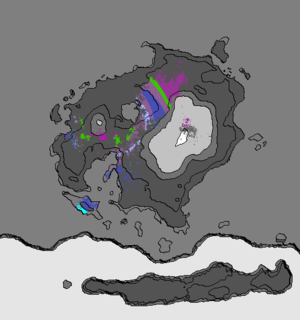Bijeko-Lisea-Nas: Difference between revisions
Newzimiagov (talk | contribs) No edit summary |
Newzimiagov (talk | contribs) |
||
| Line 10: | Line 10: | ||
==Vocalizations== | ==Vocalizations== | ||
===Hunting Calls=== | ===Hunting Calls=== | ||
Though generally a silent, solitary predator, the Bijeko-Lisea-Nas will sometimes form pairs, or small groups of three | Though generally a silent, solitary predator, the Bijeko-Lisea-Nas will sometimes form pairs, or small groups of three or four members, especially while hunting during mating season. During these periods, the Bijeko will communicate with one another using a broad range of vocalizations, some more complex than others.. Notable such vocalizations include a very loud whistle or chirping sound, which the Bijeko emits to alert its hunting companions of a potential kill. This particular vocalization is well known to those who travel along the highways of [[Corum]]; those who hear it are known to immediately utter a special prayer for protection. | ||
Below, a recording of the hunting call of the Bijeko-Lisea-Nas, recorded in the [[Afrikaanian Woodlands]]: | Below, a recording of the hunting call of the Bijeko-Lisea-Nas, recorded in the [[Afrikaanian Woodlands]]: | ||
Revision as of 07:46, 26 December 2016

A ferocious, solitary land predator, the Bijeko-Lisea-Nas is a prominent cause of concern for anyone crossing along the long highways of Northern Corum, especially for those individuals who risk traveling alone. Reaching sizes of up to three meters long, and weights of up to 700 pounds, this creature features a set of extraordinarily powerful jaws, which it uses to crush the skull of its helpless prey. In light of its fearsome reputation, hunters across the region often leave portions of their kills scattered across the country-side, as a sort of offering to this powerful predator.
In the contemporary views of the Pallisican Religion, the Bijeko-Lisea-Nas is closely associated with the Pallisican Host Spirit. The Bijeko, according to some Pallisican denominations, is the permanent companion of the Host Spirit.
Found in 6 out of 20 Pallisican cities in Corum, this species is common.
Vocalizations
Hunting Calls
Though generally a silent, solitary predator, the Bijeko-Lisea-Nas will sometimes form pairs, or small groups of three or four members, especially while hunting during mating season. During these periods, the Bijeko will communicate with one another using a broad range of vocalizations, some more complex than others.. Notable such vocalizations include a very loud whistle or chirping sound, which the Bijeko emits to alert its hunting companions of a potential kill. This particular vocalization is well known to those who travel along the highways of Corum; those who hear it are known to immediately utter a special prayer for protection.
Below, a recording of the hunting call of the Bijeko-Lisea-Nas, recorded in the Afrikaanian Woodlands:

